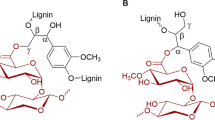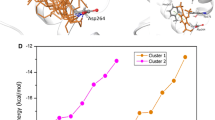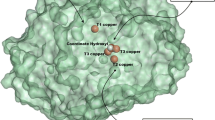Abstract
Lignin, a major constituent of plant call wall, is a phenolic heteropolymer. It plays a major role in the development of plants and their defense mechanism against pathogens. Therefore Lignin biosynthesis is one of the critical metabolic pathways. In lignin biosynthesis, the Cinnamoyl CoA reductase is a key enzyme which catalyzes the first step in the pathway. Cinnamoyl CoA reductase provides the substrates which represent the main transitional molecules of lignin biosynthesis pathway, exhibits a high in vitro kinetic preference for feruloyl CoA. In present study, the three-dimensional model of cinnamoyl CoA reductase was constructed based on the crystal structure of Grape Dihydroflavonol 4-Reductase. Furthermore, the docking studies were performed to understand the substrate interactions to the active site of CCR. It showed that residues ARG51, ASN52, ASP54 and ASN58 were involved in substrate binding. We also suggest that residue ARG51 in CCR is the determinant residue in competitive inhibition of other substrates. This structural and docking information have prospective implications to understand the mechanism of CCR enzymatic reaction with feruloyl CoA, however the approach will be applicable in prediction of substrates and engineering 3D structures of other enzymes as well.










Similar content being viewed by others
References
Li L, Cheng X, Lu S, Nakatsubo T, Umezawa T, Chiang VL (2005) Clarification of cinnamoyl co-enzyme a reductase catalysis in monolignol biosynthesis of aspen. Plant Cell Physiol 46:1073–1082
Thumma BR, Nolan MF, Evans R, Moran GF (2005) Polymorphisms in Cinnamoyl CoA Reductase (CCR) are associated with variation in microfibril angle in eucalyptus spp. Genetics 171:1257–1265
Lacombe E, Hawkins S, Doorsselaere JV, Piquemal J, Goffner D et al. (1997) Cinnamoyl CoA reductase, the first committed enzyme of the lignin branch biosynthetic pathway: Cloning, expression and phylogenetic relationships. Plant J 11:429–441
Lauvergeat V, Rech P, Jauneau A, Guez C, Coutos-Thevenot P et al. (2002) The vascular expression pattern directed by the Eucalyptus gunnii cinnamyl alcohol dehydrogenase Eg CAD2 promoter is conserved among woody and herbaceous plant species. Plant Mol Biol 50:497–509
Baltas M, Lapeyre C, Bedos-Belval F, Maturano M, Saint-Aguet P, Roussel L, Duran H, Grima-Pettenati J (2005) Kinetic and inhibition studies of cinnamoyl-CoA reductase 1 from Arabidopsis thaliana. Plant Physiol Biochem 43:746–753
Dixon RA, Chen F, Guo D, Parvathi K (2001) The biosynthesis of monolignols: a ‘metabolic grid’, or independent pathways to guaiacyl and syringyl units. Phytochemistry 57:1069–1084
Kawasaki T, Koita H, Nakatsubo T, Hasegawa K, Akabayashi K, Akahashi H, Umemura K, Umezawa T, Shimamoto K (2006) Cinnamoyl-CoA reductase, a key enzyme in lignin biosynthesis, is an effector of small GTPase Rac in defense signaling in rice. PNAS 103:230–235
Ma QH (2007) Characterization of a cinnamoyl-CoA reductase that is associated with stem development in wheat. J Exp Bot 58:2011–2021
Moershbacher B, Noll U, Gorrichon L, Reisener HJ (1990) Specific inhibition of lignifications breaks hypersensitive resistance of wheat to stem rust. Plant Physiol 93:465–470
Boerjan W, Ralph J, Baucher M (2003) Lignin biosynthesis. Annu Rev Plant Biol 54:519–546
Jones L, Ennos AR, Turner SR (2001) Cloning and characterization of irregular xylem4 (irx4): a severely lignin-deficient mutant of Arabidopsis. Plant J 26:205–216
Luderitz T, Grisebach H (1981) Enzymic synthesis of lignin precursors. Comparison of cinnamoyl-CoA reductase and cinnamyl alcohol: NADP+ dehydrogenase from spruce (Picea abies L.) and soyabean (Glycine max L.). Eur J Biochem 119:115–124
Goffner D, Cambell MM, Campargue C, Clastre M, Borderies G, Boudet A, Boudet AM (1994) Purification and characterization of cinnamoyl-coenzyme A: NADP oxidoreductase in Eucalyptus gunii. Plant Physiol 106:625–632
Piquemal J, Lapierre C, Myton K, O’ Connel A, Schuch W, Grima-Pettenati J, Boudet AM (1998) Down-regulation of cinnamoyl- CoA reductase induces significant changes of lignin profiles in transgenic tobacco plants. Plant J 13:71–83
Sarni F, Grand C, Boudet AM (1984) Purification and properties of cinnamoyl-CoA reductase and cinnamyl alcohol dehydrogenase from poplar stems (Populus X euramerican). Eur J Biochem 139:259–265
Meng H, Campbell WH (1998) Substrate profiles and expression of caffeoyl coenzyme A and caffeic acid O-methyltransferases in secondary xylem of aspen during seasonal development. Plant Mol Biol 38:513–520
N Phogat, V Vindal, V Kumar, Krishna K Inampudi, Nirmal K Prasad (2010) Sequence analysis, in silico modeling and docking studies ofCaffeoyl CoA-O-methyltransferase of Populus trichopora. J Mol Model (In Press)
Berman HM, Westbrook J, Feng Z, Gilliland G, Bhat TN, Weissig H, Shindyalov IN, Bourne PE (2000) The protein data bank. Nucleic Acids Res 28:235–242
Larkin MA, Blackshields G, Brown NP, Chenna R, McGettigan PA, McWilliam H, Valentin F, Wallace IM, Wilm A, Lopez R, Thompson JD, Gibson TJ, Higgins DG (2007) Clustal W and clustal X version 2.0. Bioinformatics 23:2947–2948
Sali A, Blundell TL (1993) Comparative protein modelling by satisfaction of spatial restraints. J Mol Biol 234:779–815
Eswar N, Marti-Renom MA, Webb B, Madhusudhan MS, Eramian D, Shen M, Pieper U, Sali A (2006) Comparative protein structure modeling with MODELLER. Current protocols in bioinformatics. Wiley, Suppl 15, 5.6.1-5.6.30
Phillips JC, Braun R, Wang W, Gumbart J, Tajkhorshid E, Villa E, Chipot C, Skeel RD, Kale L, Schulten K (2005) Scalable molecular dynamics with NAMD. J Comput Chem 26:1781–1802
MacKerell AD Jr, Brooks B, Brooks CL III, Nilsson L, Roux B, Won Y, Karplus M (1998) CHARMM: The energy function and its parameterization with an overview of the program. In: Schleyer PVR et al. (eds) The encyclopedia of computational chemistry 1. Wiley, Chichester, pp 271–277
MacKerell AD et al. (1998) All-atom empirical potential for molecular modeling and dynamics studies of proteins. J Phys Chem B 102:3586–3616
Willard L, Ranjan A, Zhang H, Monzavi H, Boyko RF, Sykes BD, Wishart DS (2003) VADAR: a web server for quantitative evaluation of protein structure quality. Nucleic Acids Res 31:3316–3319
Laskowski RA, MacArthur MW, Moss DS, Thornton JM (1993) PROCHECK: a program to check the stereochemical quality of protein structures. J Appl Crystallogr 26:283–291
Dundas J, Ouyang Z, Tseng J, Binkowski A, Turpaz Y, Liang J (2006) CASTp: computed atlas of surface topography of proteins with structural and topographical mapping of functionally annotated residues. Nucleic Acids Res 34:W116–118
Jones G, Willett P, Glen RC (1995) Molecular recognition of receptor sites using a genetic algorithm with a description of desolvation. J Mol Biol 245:43–53
Jones G, Willett P, Glen RC, Leach AR, Taylor R (1997) Development and validation of a genetic algorithm for flexible docking. J Mol Biol 267:727–748
Verdonk ML, Cole JC, Hartshorn MJC, Murray W, Taylor RD (2003) Improved protein-ligand docking using GOLD. Proteins 52:609–623
Wang Y, Xiao J, Suzek TO, Zhang J, Wang J, Bryant SH (2009) PubChem: a public information system for analyzing bioactivities of small molecules. Nucleic Acids Res 6:1–11
Pedretti A, Villa L, Vistoli G (2004) VEGA - An open platform to develop chemo-bioinformatics applications, using plug-in architecture and script" programming". J Comput Aided Mater Des 18:167–173
Acknowledgments
Research in VV’s laboratory is supported by XI OBC plan grant of University of Hyderabad. The authors wish to thank Prof. U.M.X. Sangodkar for his valuable suggestions.
Author information
Authors and Affiliations
Corresponding author
Rights and permissions
About this article
Cite this article
Prasad, N.K., Vindal, V., Kumar, V. et al. Structural and docking studies of Leucaena leucocephala Cinnamoyl CoA reductase. J Mol Model 17, 533–541 (2011). https://doi.org/10.1007/s00894-010-0744-2
Received:
Accepted:
Published:
Issue Date:
DOI: https://doi.org/10.1007/s00894-010-0744-2




